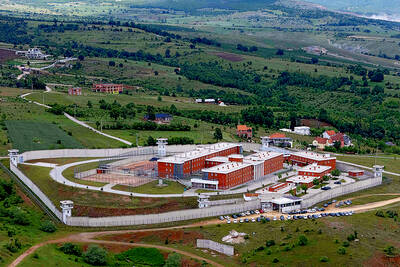Disasters last year displaced three times more people than violent conflicts, showing the urgent need to improve resilience for vulnerable people when fighting climate change, according to a study issued yesterday.
The Norwegian Refugee Council, an independent group that focuses on emergency aid, released the findings ahead of a UN summit on Tuesday aimed at building momentum for a global agreement on climate change.
The report said that 22 million people were displaced last year due to disasters brought on by natural hazards, nearly three times the number who were forced from their homes due to violence.
The problem has been worsening, with roughly twice as many people displaced around the world due to disasters now than in the 1970s, even as better forecasting and relief operations have reduced the number of deaths.
“It’s a wake-up call, I think, to world leaders coming here — as bad as it is today, it would be dramatically worse unless much more is invested in resilience,” Norwegian Refugee Council Secretary-General Jan Egeland said. “We have to make people in the Philippines or Chad or in Haiti as resilient as we are in Norway or in many parts of the United States.”
Egeland is a former UN emergency relief coordinator who played a high-profile role drumming up international support after the 2004 Indian Ocean tsunami.
He cited the experience as a model, saying that the more than US$13 billion that poured in after the tsunami went not only for reconstruction, but also built up resilience for future disasters.
Such an effort needs to happen on a global scale as “we need to get people out of this vicious cycle of being vulnerable and therefore being hit very hard again,” he said.
UN Secretary-General Ban Ki-moon has called Tuesday’s summit to mobilize world leaders before next year’s conference in Paris that is meant to draft a new global agreement on climate change.
The Norwegian study pointed to findings of a UN-led scientific panel, the Intergovernmental Panel on Climate Change, which has said that human activity is contributing to the greater frequency and intensity of disasters around the planet.
However, the report said that a sharp rise in urbanization and bad planning were also factors in explaining the steep rise in disaster displacement.
“We are not saying here that it’s climate change that has explained the increase. It’s just as much, or more, population growth and urbanization, bad planning and more exposure to the elements,” Egeland said.
More than 80 percent of the people displaced by natural disasters last year were in Asia, the report found. The Philippines suffered the two most disruptive disasters last year, with Typhoon Haiyan — also known as Yolanda — and Typhoon Trami together displacing 5.8 million people.
Relative to population size, eight of the 20 most disruptive natural disasters were in sub-Saharan Africa. The study warned of growing risks to Africa as the continent experiences higher population growth than other regions.
Wealthy nations were not immune, with a typhoon in Japan’s Chubu region, tornadoes in the US and floods in the Canadian province of Alberta together displacing nearly 600,000 people.
The study also warned of growing risks of natural disasters hitting nations that are also in conflict. It pointed to the 2010 floods that swamped Pakistan as an example of a disaster hitting a fragile state.

Packed crowds in India celebrating their cricket team’s victory ended in a deadly stampede on Wednesday, with 11 mainly young fans crushed to death, the local state’s chief minister said. Joyous cricket fans had come out to celebrate and welcome home their heroes, Royal Challengers Bengaluru, after they beat Punjab Kings in a roller-coaster Indian Premier League (IPL) cricket final on Tuesday night. However, the euphoria of the vast crowds in the southern tech city of Bengaluru ended in disaster, with Indian Prime Minister Narendra calling it “absolutely heartrending.” Karnataka Chief Minister Siddaramaiah said most of the deceased are young, with 11 dead

By 2027, Denmark would relocate its foreign convicts to a prison in Kosovo under a 200-million-euro (US$228.6 million) agreement that has raised concerns among non-governmental organizations (NGOs) and residents, but which could serve as a model for the rest of the EU. The agreement, reached in 2022 and ratified by Kosovar lawmakers last year, provides for the reception of up to 300 foreign prisoners sentenced in Denmark. They must not have been convicted of terrorism or war crimes, or have a mental condition or terminal disease. Once their sentence is completed in Kosovan, they would be deported to their home country. In

DENIAL: Musk said that the ‘New York Times was lying their ass off,’ after it reported he used so much drugs that he developed bladder problems Elon Musk on Saturday denied a report that he used ketamine and other drugs extensively last year on the US presidential campaign trail. The New York Times on Friday reported that the billionaire adviser to US President Donald Trump used so much ketamine, a powerful anesthetic, that he developed bladder problems. The newspaper said the world’s richest person also took ecstasy and mushrooms, and traveled with a pill box last year, adding that it was not known whether Musk also took drugs while heading the so-called US Department of Government Efficiency (DOGE) after Trump took power in January. In a

LOST CONTACT: The mission carried payloads from Japan, the US and Taiwan’s National Central University, including a deep space radiation probe, ispace said Japanese company ispace said its uncrewed moon lander likely crashed onto the moon’s surface during its lunar touchdown attempt yesterday, marking another failure two years after its unsuccessful inaugural mission. Tokyo-based ispace had hoped to join US firms Intuitive Machines and Firefly Aerospace as companies that have accomplished commercial landings amid a global race for the moon, which includes state-run missions from China and India. A successful mission would have made ispace the first company outside the US to achieve a moon landing. Resilience, ispace’s second lunar lander, could not decelerate fast enough as it approached the moon, and the company has